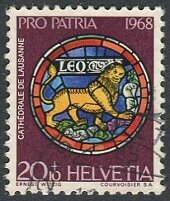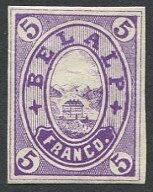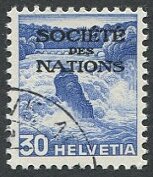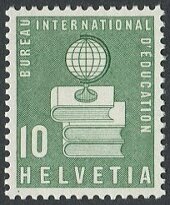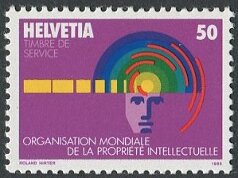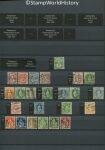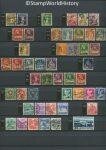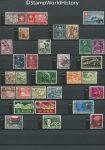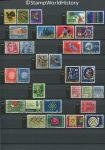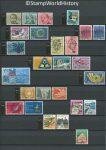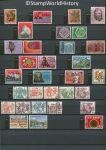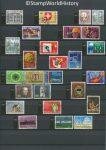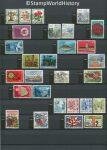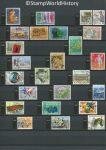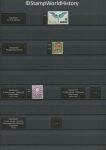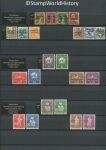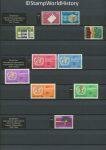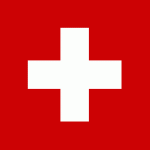
Switzerland
Quick reference
General issues: Federal republic 1850-Present
Country name on general issues: None, Helvetia, Confederatio Helvetica
Special issues:
- Cantonal issues: Basel 1845, Geneva 1843-1849, Zurich 1843
- Postal district issues: Post district I 1849-1851, Post district VII 1850
- Private issues: Hotel post 1864-1883 Belalp, Maderanertal, Rigi-Kaltbad, Rigi-Kulm, Rigi-Scheideck, Stoos
- Private issues: Air post 1913 Aarau, Basel, Bern, Burgedorf, Herisau, Langnau, Laufen, Liestal, Lugano, Sion, Solothurn
- International organizations:
- League of Nations 1922-1944
- United Nations 1950-1963
- International Bureau of Education 1944-1960
- International Labour Organization 1923-Present
- International Refugee Organization 1950
- International Telecommunication Union 1958-Present
- Universal Postal Union 1957-Present
- World Health Organization 1948-Present
- World Intellectual Property Organization 1982-1985
- World Meteorological Organization 1956-1973
- International Olympic Committee 2000-Present
Currency: 1 Franken, Franc, Franco = 100 Rappen, Centimes, Centesimi 1850-Present
Population: 3 315 000 in 1900, 8 179 000 in 2016
Political history Switzerland
Shaping Switzerland
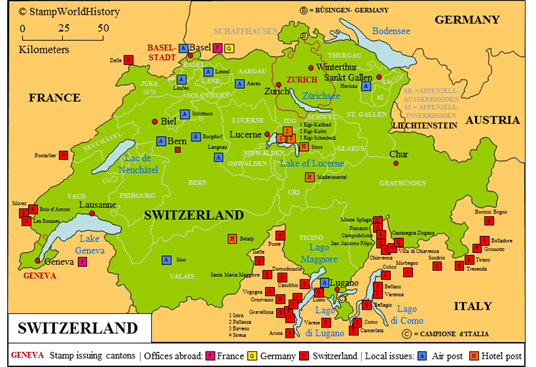
Please click on the image to enlarge, click here for the PDF version of the image
Switzerland is located in western Europe. The history of Switzerland as a distinct political entity started in 1291 when three cantons [1]Strictly speaking the term canton was introduced in the late 15th century. formed the Swiss Confederation.[2]The cantons of Schwyz, Unterwalden and Uri. In the following centuries the Confederation gradually expanded. Five cantons joined the Confederation in the 14th century,[3]The cantons of Bern, Glarus, Lucerne, Zug and Zurich. five more in the late 15th and early 16th century.[4]The cantons of Appenzell, Basel, Fribourg, Schaffhausen and Solothurn. Full independence of the Confederation was recognized in 1648. The Confederation took its final shape during the French and Napoleonic Wars. In 1803, six territories that had been associated with, or subject to, existing cantons were admitted to the Confederation as cantons.[5]The cantons of Aargau, Graubünden, St. Gallen, Thurgau, Ticino and Vaud. At the end of the Napoleonic Wars, during the Congress of Vienna in 1815 – where the map of 19th century Europe was drawn – three more cantons were joined to the Confederation, bringing the total to twenty two.[6]The cantons of Geneva, Neuchâtel and Valais. Thus, in 1815, the borders of Switzerland were established as we know them today. Within these borders, the number of cantons eventually increased to twenty six. In 1979, Jura was detached from Bern and established as a separate canton. In 1999, the constitution was amended and three cantons were divided in two cantons each – a de jure confirmation of a de facto status that had existed for centuries.[7]The canton of Appenzell was divided into Appenzell Innerrhoden and Appenzell Ausserrhoden, Basel into Basel-Stadt and Basel-Land and Unterwalden into Nidwalden and Obwalden.
Within its borders Switzerland has two exclaves: the German exclave of Büsingen in the canton of Schaffhausen and the Italian exclave of Campione d’Italia in the canton of Ticino.
From confederation to federation

Switzerland is synonymous with the Alps, the highest mountain range in Europe.
In the 16th century, the Protestant Reformation had significant impact on Switzerland. Several cantons turned Protestant while other cantons remained Catholic. Tensions between the Protestant, more liberal cantons, and Catholic, more conservative cantons, soon developed. These tensions led to conflicts several times and continued into the 19th century. In 1847, the tensions escalated into a short civil war. In the aftermath of the war, the Swiss decided to transform the confederation to a federation in which the cantons transferred their sovereignty to a federal government. A federal constitution – based on the United States model – was adopted in 1848. Switzerland as been a federation since then. Although the cantons relinquished their full sovereignty, they enjoy a large degree of self government until today – with their own constitutions, parliaments and courts. A further characteristic of the Swiss political system is the high degree of direct democracy – the referendum plays an important part in Swiss politics.
Neutrality

Wilhelm Tell is the Swiss national figure. Tell is supposed to have lived around 1300 and symbolizes the fight for freedom of the Swiss Confederation. The statue is found in Altdorf, canton Uri and dates from 1895.
In its external policy, Switzerland has, for centuries, adhered to a policy of neutrality. Swiss neutrality was first recognized internationally when the Swiss Confederation gained full independence in 1648. It was confirmed at the Congress of Vienna in 1815. Thus, Switzerland has retained neutrality in many of the conflicts that were part of European history, including WWI and WWII. In the second part of the 20th century, Switzerland has declined to become part of the European Union, although the country has aligned itself with developments in the European Union as a member of a number of European institutions and through a range of treaties. Switzerland joined the United Nations in 2002. The strict policy of neutrality is probably one of the reasons why many international organizations have set up their headquarters in Switzerland.
Economy and demography
Switzerland industrialized in the second half of the 19th century. In the 20th century Switzerland developed into a services economy. Banking is one of the strong sectors of the Swiss economy. Switzerland is one of the wealthiest nations in the world. On the United Nations Human Development Index, Switzerland ranks third.
The Swiss population reflects its location at the center of Europe. The largest ethnic group is German at 65%, followed by the French at 18%, the Italians at 10% and the Romansch at 1%. German, French, Italian and Romansch are official languages in Switzerland. Switzerland is one of the countries with the highest number of foreign residents – 24% of the total number of residents.
Postal history Switzerland
Cantonal and postal district issues
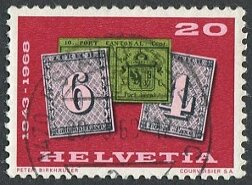
1968 – Issued at the 125th anniversary of Swiss stamps. Shown are the 1843 Zurich and Geneva issues.
The first stamps issued in Switzerland were issued by individual cantons. Zurich was the first canton to issue stamps in early 1843. Zurich issued stamps in two denominations – one for local mail, inscribed ‘Local-Taxe’, and one for cantonal mail, inscribed ‘Cantonal-Taxe’. Geneva followed suit later in 1843. In Geneva the first stamps were issued in pairs. Each individual stamp was valid for local mail and inscribed ‘Port local’. The pair was valid for cantonal mail and was, above the two individual stamps, inscribed ‘Port cantonal’. The canton of Basel-Stadt issued a stamp for local mail in 1845. All these cantonal issues rank in the very high catalog value range.
In 1849, the postal services were taken over by the federal authorities. Switzerland was now organized into a number of postal districts. During a transitional phase, before the first stamps were issued by the federal authorities, these districts were allowed to issue stamps for use in ‘densely populated areas in which significant amounts of mail was sent’. Thus, in 1849 and 1850, stamps were issued for local mail in Post District I, which comprised the canton of Geneva and part of the canton of Vaud.[8]These 1849 and 1850 issues are known as the ‘Vaud’ issues. A further issue appeared in Post District I in 1851 – after the introduction of federal stamps. It is suggested that this issue appeared because Geneva resented the fact that denomination of the first federal stamps was in German ‘rappen’ rather than French ‘centimes’.[9]This 1851 issue is known as the ‘Neuchâtel’ issue. Furthermore, in 1850, a stamp was issued for local mail in Post District VII which comprised the cantons of Zürich, Schaffhausen, Thurgau und Zug.[10]This issue is known as the ‘Winterthur’ issue. Like the cantonal issues, the postal district issues all rank in the very high catalog value range.[11]Scott does not make a distinction between cantonal and postal district issues. The postal district issues discussed are Scott numbers 2L5-2L7 and 1L5.
General issues
On the federal level, the first stamps were issued in 1850. The first issues were inscribed ‘Ortspost’ or ‘Poste Locale’ and were valid for use on local mail. Later in 1850, stamps were issued inscribed ‘Rayon I’ and ‘Rayon II’. In 1852, a stamp was issued inscribed ‘Rayon III’. ‘Rayon’ is probably best translated as ‘range’ as the Rayons indicated the distance mail could travel when franked with the Rayon I, II, and III stamps. That distance was calculated in both hours of road travel and kilometers:
- Rayon I was valid for mail travelling up to 2 hours or 9.6 kilometers,
- Rayon II for mail travelling up to 10 hours or 50 kilometers, and
- Rayon III for mail travelling up to 40 hours or 200 kilometers.
A Rayon IV existed for distances above 40 hours or 200 kilometers. Mail for Rayon IV was franked with two Rayon II stamps. Interesting though these stamps may be, they are above the means of the average collector, as the catalog values are again in the very high range.
The cantonal, postal district and the first federal issues were all valid until 1854, when they were superseded by the first ‘Sitting Helvetia’ issues. Starting with this issue the stamps of Switzerland are inscribed ‘Helvetia’. Helvetia is the Latin name for Switzerland and provided a neutral alternative in a country with four official languages. Switzerland, from the ‘Sitting Helvetia’ issues until the present day, mainly issued stamps with themes of national interest.
Semi-postals
Switzerland is known for the significant number of semi-postals[12]Semi-postals are stamps sold at a price greater than the postal value, with the additional charge being dedicated for a special purpose. that are issued. In particular, two series of semi-postals have a long history. The first series are the ‘Pro Juventute’ issues that first appeared in 1913. Pro Juventute is a foundation, established in 1912, that raises funds to support the interests of children. Since 1915, a set of ‘Pro Juventute’ stamps is issued yearly. Likewise, ‘Pro Patria’ semi-postals are issued on a yearly basis. Pro Patria is a foundation that was established in 1909 and raises funds to support cultural and social goals.[13]Strictly speaking the current Pro Patria foundation was established in 1991 as the successor of the ‘Verein Schweizerische Bundesfeier-Spende’ – the ‘Association for the Swiss Federal Celebration Donation’ – established in 1909 Since 1910, postcards have been issued. ‘Pro Patria’ semi-postals have been issued since 1936. The ‘Pro Juventute’ issues are easily identified as they are inscribed ‘Pro Juventute’ since the first issue in 1913. The earlier ‘Pro Patria’ issues are less easy to identify because the ‘Pro Patria’ issues are inscribed ‘Pro Patria’ since 1952 only.[14]The Michel catalog identifies the earlier ‘Pro Patria’ issues as such, Scott does not.
Private issues
The Michel catalog refers to private issues known as ‘Hotel Post’ stamps and lists private air post stamps issued in the context of the Schweizerische Nationale Flugspende[15]Swiss National Aviation Donation in 1913 .
The first Hotel Post issues appeared in 1864. At the time, the Swiss postal service was in development. Tourism had developed rapidly in Switzerland, since the mid 19th century, and hotels were often found at locations not yet reached by the postal services. As a service for their guests, hotels would transport mail to the nearest post office. The Hotel Post stamps were issued by these hotels to cover the cost of this service. As the postal services were expanded, the need for these issues diminished and, in 1883, the Hotel Post issues were prohibited.[16]The Michel world wide catalog refers to these issues. A listing is found in the Michel Switzerland specialized catalog.
Private air post stamps were issued in 1913 in the context of the Schweizerische Nationale Flugspende, a campaign launched by the government to further the awareness of the public for the need of military aviation. In a range of cities, flights were organized for the promotion of the campaign. These flights also carried mail and, with permission of the postal authorities, stamps were issued by the local organizing committees to be used in addition to the regular stamps used to frank the mail. The covers were furthermore cancelled with specially prepared cancels. Michel lists eleven such issues – all of different designs and all ranking in the high catalog value range.
International organizations
Switzerland is home to a range of international organizations. For a number of these organizations, official stamps have been issued by the Swiss postal service. The issues are either Swiss stamps overprinted with a designation for the respective organizations or definitives inscribed ‘Helvetia’ and a designation for the organizations. The designations generally are in French. An overview:[17]The dates for the most recent issues are based on the 2013 edition of the Michel catalog
-
League of Nations. The League of Nations was established in 1920 as an intergovernmental organization with the aim to maintain world peace by preventing wars and settling international disputes through negotiation and arbitration. In 1946, the League of Nations was dissolved to be succeeded by the United Nations. The League of Nations had its seat in Geneva. Stamps were issued for the League of Nations from 1922. All stamps issued for the League of Nations are overprinted Swiss stamps. Mint items generally have significantly higher catalog values than used items because it was, until 1944, an explicit policy not to sell mint items to the stamp collecting world. The last stamps were issued in 1944.
- United Nations. The United Nations was established in 1945 and was the successor of the League of Nations. The United Nations has its main seat in New York and further headquarters in Geneva, Vienna and Nairobi. The Geneva office was opened in 1946 and is the second largest of the United Nations headquarters. Stamps for the United Nations office in Geneva were issued by the Swiss postal service between 1950 and 1963 and valid for use until 1969. In 1969, the United Nations started its own stamp issuing policy. The issues after 1969 are the subject of a separate profile on the United Nations – Geneva. For more about the United Nations as an organization, please refer to the profile of the United Nations – New York.
-
International Bureau of Education – IBE. The IBE was founded in 1926 and is a center of excellence for the development of curricula in the field of education. The IBE was founded as a private organization and became an intergovernmental organization in 1929. In 1969, the IBE became an institute of UNESCO[18]United Nations Educational, Scientific and Cultural Organization . The IBE has its seat in Geneva. Stamps were issued for the IBE between 1944 and 1960.
- International Labour Organization – ILO. The ILO was established in 1919 to further world wide labor rights and in 1920 became an agency of the League of Nations. Currently, the ILO is a specialized agency of the United Nations. The ILO has its seat in Geneva. The first stamps for the ILO appeared in 1923. As with the issues for the League of Nations, the early mint items generally have significantly higher catalog values than used items. The most recent issue for the ILO dates from 1994.
- International Refugee Organization – IRO: The IRO was founded in 1946 to deal with the large numbers of refugees caused by WWII and functioned as a United Nations special agency. In 1952, the activities of the IRO were taken over by the UNHCR[19]United Nations High Commisioner for Refugees . The IRO had its seat in Geneva. Stamps were issued for the IRO in 1950.
-
International Telecommunication Union – ITU. The ITU was founded in 1863 as the International Telegraph Union. Thus, it is one of the oldest intergovernmental organizations. Since 1949, the ITU is a specialized agency of the United Nations responsible for information and communication technology. The ITU has its seat in Geneva. Stamps have been issued for the ITU since 1958. The most recent issue dates from 2003.
- Universal Postal Union – UPU. The UPU was founded in 1874 and was integrated into the United Nations system as a specialized agency in 1948. The UPU coordinates postal policies of member countries and the worldwide exchange of mail. The UPU has its seat in Bern. Stamps have been issued for the UPU since 1957. The most recent issue appeared in 2012.
- World Health Organization – WHO. The WHO was founded in 1948 as a specialized agency of the United Nations. Its aim is ‘the attainment by all people of the highest possible level of health’. The WHO has its seat in Geneva. Stamps have been issued for the WHO since 1948. The most recent issue dates from 1995.
-
World Intellectual Property Organization – WIPO. The WIPO was established in 1967 as a specialized agency of the United Nations. It is the successor of the United International Bureau for the Protection of Intellectual Property that had been established in 1893. Its aim is to promote the protection of intellectual property world wide. The WIPO has its seat in Geneva. Stamps have been issued for the WIPO in 1982 and 1985.
- World Meteorological Organization – WMO. The WMO was established in 1950 as a specialized agency of the United Nations and is the successor of the International Meteorological Organization that had been established in 1873. The WMO furthers the free international exchange and application of meteorological data and information. The WMO has its seat in Geneva. Stamps have been issued for the WMO between 1956 and 1973.
- International Olympic Committee – IOC. The IOC was founded in 1894 and organizes the Olympics. It is the only organization not related to the United Nations for which stamps are issued. The IOC has its seat in Lausanne. Stamps have been issued for the IOC since 2000. The most recent issue dates from 2008.
Offices abroad
In the 19th century French post offices operated in Basel and Geneva. A post office from the former kingdom of Baden, since 1871 a German post office, operated in Basel. Switzerland, until 1921, operated a range of post offices in Italy and to a lesser extent in France. The stamps of Switzerland were used between 1944 and 1952 in the Italian exclave of Campione.
Album pages
Album pages International organizations
← Previous page: SwedenNext page: United Nations - Geneva →


